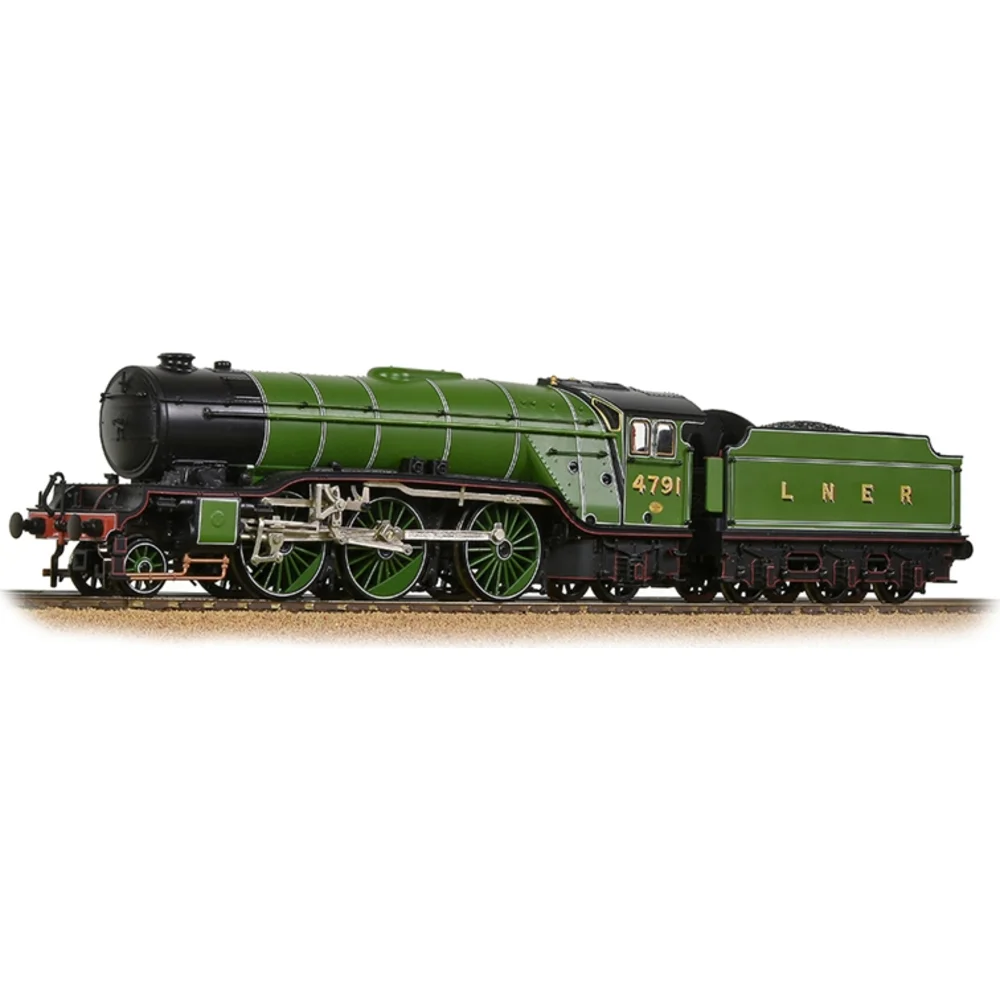Bachmann 35-200
London & North Eastern Railway V2 4791 London & North Eastern Railway Lined Apple Green
Tooling
In Summer 2021, Bachmann Branchline unveiled a completely new tooling for the LNER Class V2 in OO gauge, replacing the previous 2012 design. This retooling was developed to meet modern standards of accuracy, mechanical performance, and digital capability. The V2, designed by Sir Nigel Gresley, was a mixed-traffic locomotive built between 1936 and 1944, and remains a favourite among enthusiasts for its versatility and wartime service.
Tooling Features
- Scale: OO gauge (1:76).
- Construction: High-fidelity injection-moulded bodyshell with a die-cast chassis block for strength and weight.
- Detailing: Separately fitted handrails, lamp irons, lubricators, and fine valve gear. Fully detailed cab interior with painted controls, seats, and glazing. Etched nameplates supplied for named locomotives.
- Couplings: NEM coupling pockets with tension-lock couplers; sprung buffers. Semi-permanent close-coupling drawbar between loco and tender with integrated electrical connections.
Mechanical & Electrical
- Motor & Drive: Powerful 5-pole motor with smooth gearing for reliable performance.
- Minimum Radius: Recommended for second radius curves (approx. 438 mm).
- Lighting: Firebox glow on analogue; firebox glow and flicker effects on DCC.
- Weighting: Die-cast chassis and tender components provide good traction.
DCC Capability
- DCC Ready with a 21-pin socket located in the tender.
- Factory-fitted sound versions available using ESU Loksound V5 decoders, offering a full suite of steam sounds and synchronized firebox lighting effects.
Liveries Produced
The 2021 tooling has been released in a range of authentic schemes, including:
- LNER Lined Green (original style)
- BR Lined Black (early emblem)
- BR Green (late crest)
- Special editions such as preserved No. 4771 “Green Arrow”
Reviews & Commentary
The new V2 was widely praised for its fine detailing, realistic cab interior, and improved mechanism. Features such as the firebox glow and sound options were highlighted as standout additions. However, some reviewers and forum discussions noted issues with overscale valve gear, visible boiler seam lines, and high pricing. Despite these criticisms, the model was considered a significant improvement over previous versions and a strong competitor in the premium OO steam market.
Interesting Notes
- The tooling includes options for different smokebox doors and tender types, allowing accurate representation of LNER and BR variants.
- Close-coupling mechanism between loco and tender improves realism and electrical reliability.
Class & Prototype
- Class: London & North Eastern Railway V2
- Traction: Steam
- Built: 1936-1944
- Total Built: 184
- Running Number: 4791
Operator & Livery
- Operator: London & North Eastern Railway
- Livery: Lined Apple Green
- Era: 3 - The big 4 – LMS, GWR, LNER & SR
The London & North Eastern Railway emerged in 1923 as Britain's second-largest railway company, combining seven major railways including the Great Northern, North Eastern, and Great Eastern into a 6,590-mile network stretching from London's four terminals to the Scottish Highlands. Despite serving economically challenged industrial regions, the LNER achieved worldwide recognition for engineering excellence and speed records that remain unbroken today.
Under Chief Mechanical Engineers Sir Nigel Gresley, Edward Thompson, and Arthur Peppercorn, the LNER developed revolutionary locomotive designs characterised by three-cylinder layouts and streamlined aesthetics. Gresley's masterpieces included the A1 Pacifics featuring Flying Scotsman and the legendary A4 class, culminating in Mallard's world steam speed record of 126 mph in 1938.
The company pioneered luxury express services including the Silver Jubilee and Coronation streamliners, whilst investing in forward-thinking electrification schemes and massive marshalling yards. Notable achievements included operating the complete East Coast Main Line, introducing Britain's first regular 400-mile non-stop service, and commissioning Eric Gill's iconic typography that influenced railway design for decades.
Nationalised in 1948, LNER locomotives continued serving British Railways until the 1960s, with some A4 Pacifics working Scottish expresses until 1966. Today, the LNER's engineering legacy thrives through extensive preservation, new-build projects like Tornado, and comprehensive model ranges covering every major class in all popular scales, making LNER subjects essential for discerning railway modellers seeking authentic British steam-age atmosphere.
